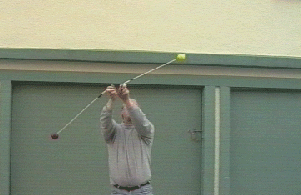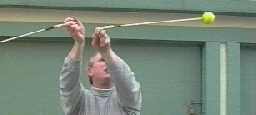Lower Fountain


close up of Upper Fountain
Once you can swing both the Forward Cross-Follow and the Reverse Cross-Follow comfortably, try to combine them into the Lower Fountain. The Lower Fountain is a great move, well worth the effort it may take to learn. To swing a Lower Fountain you swing a Forward Cross-Follow on one side of your body, and seamlessly transition to the Reverse Cross-Follow on the other side of the body.
The way to make this transition from forward to reverse swings is to turn your body 180 degrees. Let's use the unicycle analogy again. Imagine riding a unicycle forward in a straight line. Non-unicycle riders can imagine walking forward. To make this less confusing, imagine you are performing on a stage, and the unicycle is rolling stage right. The audience would see your left profile as you pedaled across the stage.
Visualize what it would be like to make a half-turn, 180 degrees, without stopping. You would still be rolling towards the same direction, stage right, but now the audience would see your right profile. You would also be pedaling backwards.
The same type of change from forward to backward would happen if you were swinging. Imagine swinging two poi balls in a Forward Cross-Follow as you slowly walk towards stage right. The audience would see your left shoulder and profile. Now imagine making a half-turn while you continue walking and swinging the poi. The audience would see your right shoulder and right profile. You would also be walking backwards, and swinging the Reverse Cross-Follow instead of the Forward Cross-Follow.
Try swinging a Forward Cross-Follow. While continuing to swing the poi, make a half-turn with your body so you are facing the opposite direction. Did you manage to keep the poi swinging? If so, congratulations. You have found the transition between the Forward and the Reverse Cross-Follow. If you can perform a series of these back and forth, you have learned the Lower Fountain.
If you are like me, and most of the people I have seen, the poi got all tangled up as you attempted the half-pirouette. Please don't get discouraged. It just means you have to build up to the pattern with some intermediary steps. Here are some thoughts to help you learn how.
It may help to imagine looking down on the swinger from above, so we have a bird's eye view. Divide the space into four quadrants. Now superimpose a clock face onto the scene. The swinger is looking straight ahead at the audience, and at twelve o'clock. Nine o'clock is at the swinger's left shoulder, and three o'clock is at the right shoulder.
Throughout the course of the Lower Fountain, the poi balls end up spending time in all four quadrants. The left rear zone mentioned previously corresponds to the quadrant between six and nine o'clock. The front center zone takes up both of the front quadrants, from nine o'clock, all the way through twelve o'clock, to three o'clock. The right rear quadrant lies between three and six o'clock on the imaginary clock face.
Keeping your feet in position, slowly turn 180 degrees clockwise so you are facing the right. As you turn, you pass back through the twelve o'clock home position. When you have finished the turn you will be facing three o'clock on the imaginary clock face. The audience would now be seeing your left profile, after having gotten a momentary full-face view.
You don't need to change the position of your feet while turning. It's enough to just pivot on the balls of your feet. When facing the right, the majority of your weight should be on the right foot.
Practice this swiveling back and forth from nine o'clock to three o'clock, and then back to nine o'clock without the poi for a while, to make sure it feels comfortable. Have your hips, shoulders, and head move as one unit.
In a standard Forward Cross-Follow, the order of the three circles is a crossed-over arm circle, a same side circle with the other hand, and a crossed-under arm circle from the first hand. In this case the right arm begins with a crossed-arm circle.
Let's think about the second circle, the left hand circle. After the left hand swings its first same-side circle, the left arm crosses over the right arm for the first cross-arm circle with the left hand. Normally, this would begin the right three circles of the Forward Cross-Follow. It might be appropriate to say left hand over at this time. You still want to cross your left arm over your right arm, and swing the white poi to the right side of your body for the Lower Fountain. However, you also want to add the motion of swiveling your body to the right as you do this. Another way to think about this is that the white poi in the left hand leads your body into turning in a clockwise direction, as viewed from above. The audience will now see you head on, instead of your right profile. Remember that as you are turning, the black poi in the right hand is finishing its second cross-arm circle.
Turn your body slowly enough so both poi have the time to swing in one full circle directly in front of you. The white poi will be leading the black poi at this time. Both poi will be circling in a counterclockwise direction as you look at them.
When the white poi finishes its counterclockwise circle in front, finish swiveling your body to the three o'clock position on the bird's eye clock. The left hand and the white poi will still be leading the black poi in one cycle of a Reverse Cross-Follow as you look off to the right. The audience would see your left profile. A good cue to say aloud might be left hand under.
That's the first half of the Lower Fountain. Essentially, you have swung six circles, three with each hand. For the first set of circles your hands were in the left rear quadrant. Each hand swung a circle as they passed through the center front zone. The left hand led the right hand into and out of the center front zone. For the start of the Reverse Cross-Follow your hands are in the right rear quadrant.
It will take another six circles to get back to your starting position. These circles begin with the hands in the right rear quadrant. After swinging the circles, the hands move back to the center front zone.
After the right hand reverse-swings the black poi for one circle in the right rear quadrant, it takes the lead. That is to say, the right hand, crossed under the left hand. swings the black poi into the center zone, as the left hand finishes up the second circle with the white poi. Swivel your body to follow the black poi and face the audience for the center circles. Saying right hand under as the right hand swings under the left and you make this transition may be useful.
After the right hand completes one front circle, bring the right arm over the left arm to begin the Forward Cross-Follow in the left rear zone. Saying "right hand over" as you do this should bring you back to you the starting position. Repeat all the moves to continue the Lower Fountain.
I have found that the verbal cues, "right hand over, left hand over, left hand under, right hand under," repeated in that order is surprisingly helpful for many people. It seems strange that such a complicated series of movements can be represented so easily. Let's add the body movement to these hand placements. For the "right hand over" you should be facing off to the left.
As you say and perform "left hand over" you should be turning and facing the audience.
Keep on turning so you are facing the overhead three o'clock position as you say "left hand under."
You should begin turning to your left, to face the audience again, around the time you say "right hand under."
Continue turning to your left, all the way to the overhead nine o'clock position as you say "right hand over" for the next cycle.
From the point of view of the audience both poi balls always swing in a clockwise direction for the entire Lower Fountain. From the swinger's point of view the poi balls seem to be traveling in clockwise circles for half of the pattern, and counterclockwise circles for the other half of the pattern.
This apparent inconsistency can better be understood if you remember that, while swinging, you are changing your point of view throughout the move. It's the same idea as the unicycle rider who begins by pedaling forward, but must pedal backwards to continue rolling stage right after a half-pirouette. For the audience, the wheel and the pedals of the unicycle don't change direction. To the rider, forward motion becomes reversed, after the turn.
To be thorough, I should point out that you can also begin with a Forward Cross-Follow from the three o'clock position. This means that there are two directions in which you can swing Lower Fountains. Oh, and you can return swinging the poi overhead instead of down low, for the Full Fountain. There is also the option of constantly turning your body in the same direction, instead of back and forth. This gives a nice visual effect of dancing across the stage as you swing the poi. Any other possibilities?

- Home
- About
- Ball Juggling
- Cigar Boxes
- Club Juggling
- Club Swinging
- Comedy Writing
- Cup Stacking
- Devil Sticks
- Diabolo
- Diabolo Postcards
- Dice Stacking
- Hat Manipulation
- Lasso
- Miscellanous Juggling
- Parachute Games
- Poi Swinging
- Ring Juggling
- Shaker Cups
- Skill Games
- Staff
- Tennis Balls and Can
- New Games Foundation
- Ordering and Shipping
- Contact Information
- Peeps (photos of birds and stuff)
- Personal Thoughts
- Workshops
- Links
- Questions? Comments? Feedback?